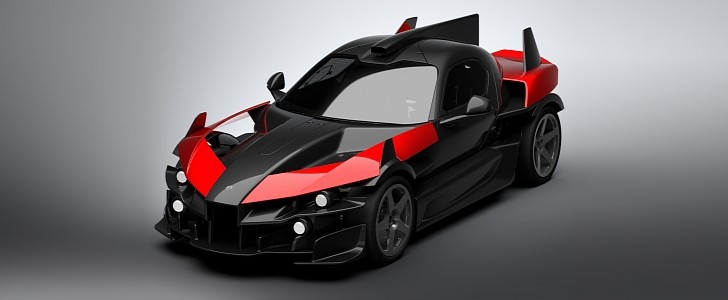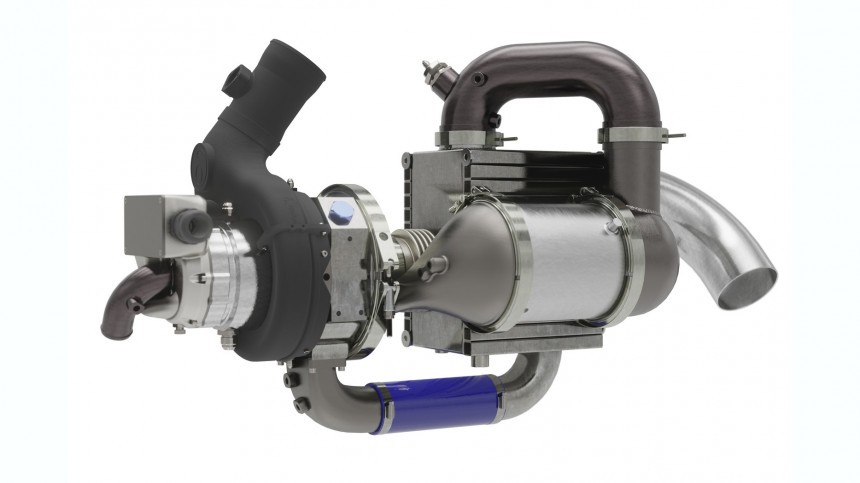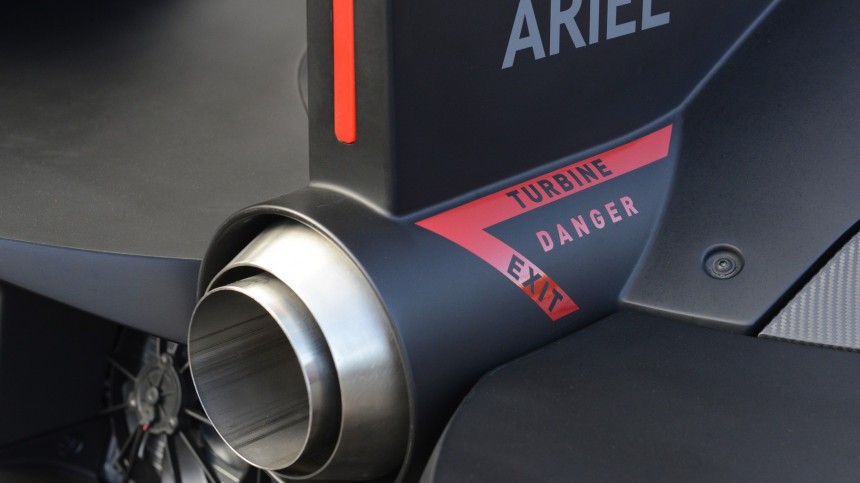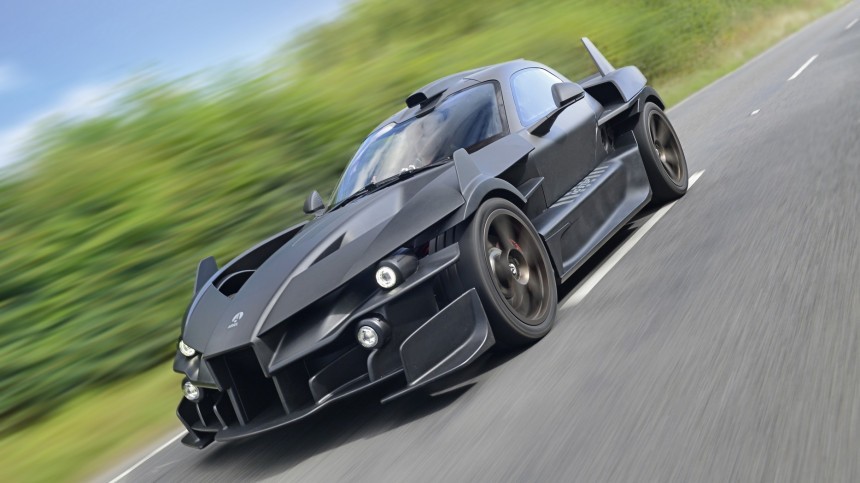Ariel Motor has given the world some impressive combustion-engined vehicles. The first one was the Atom, followed by the Nomad, and eventually by the Ace motorcycle. We did not think we would see an electric vehicle from them so soon. Yet, the HIPERCAR is here, and its technical specifications are more striking than its looks.
The name may also surprise those used with the shorter ones the British company adopts. The deal is that it does not mean what it seems. HIPERCAR is an acronym for High-Performance Carbon Reduction. In other words, the new EV has the goal of helping Ariel cut emissions and prepare it for the combustion engine ban that the UK will have starting in 2035.
The cost to shift will be hefty, especially for those willing to drive the new Ariel. Simon Saunders said the fully-loaded HIPERCAR would cost less than £1 million ($1.15 million at the current exchange rate). We said fully loaded, but the Ariel director actually mentioned the EV that comes with two motors in each axle – for a total of four – and an optional microturbine range extender.
Cosworth developed this solution. The CatGen (Catalytic Generator) microturbine is called that way because it uses a catalytic exothermic reaction as its power source. The company published an amazing video on Facebook in January to explain that, and we strongly advise you to watch it – it is embedded below.
Long story short, the process does not involve combustion. Air heated in a heat exchange chamber is mated to any sort of fuel. The mixture then crosses a catalyst that increases its temperature to 1,050ºC (1,922ºF). Cosworth defines this as a “highly-controlled heat release” – the exothermic reaction we mentioned above. As it can use any fuel, Ariel claims it may use hydrogen in the future, meaning it emits no carbon.
This heated gas then spins the microturbine, compressing even more air into the system. Before going to the exhaust pipe, this gas crosses the heat exchanger again to help heat even more air. When it leaves the microturbine, its temperature is below 350ºC (662ºF).
The turbine turns at 110,000 rpm constantly for efficiency purposes and also because its only task is to generate electricity. It has a capacity of 35 kW (47 hp), enough to make the electric Ariel go further. It also adds less than 50 kilograms (110.2 pounds) to the weight of its first closed-cabin vehicle. The British company did not disclose how much further the microturbine allows the HIPERCAR to go.
This is not the only contribution Cosworth made to this project. It also created the 800V (690V nominal), 62.2-kWh battery pack that powers the HIPERCAR. Ariel said it has an innovative liquid-cooling system that can deliver warmed or refrigerated “water-glycol coolant directly and evenly to every single cell in the pack.” There are 5,760 cylindrical 18650 cells there, divided into 32 modules with 180 batteries each.
Weirdly, Ariel states that a fully charged battery pack can deliver a WLTP range of only 150 miles (240 kilometers). That’s too little for a 62.2-kWh battery pack in such a light vehicle. The HIPERCAR 4WD with the microturbine range extender weighs 1,546 kg (3,408 lb). If you compare it to a Peugeot e-208, it has a 50 kWh battery pack, a WLTP range of 349 km (217 mi), and weighs 1,560 kg (3,439 lb).
That probably has to do with the high-performance proposition of the HIPERCAR. Ariel disclosed a 0 to 60 mph (97 kph) time of 2.09 seconds, which it believes can be even lower when it has fully developed the adjustable torque vectoring system the production car should present. The top speed is 155 mph (250 kph) and is electronically limited. The design is an excellent example of “form follows function.”
The Ariel HIPERCAR is 4.30 meters (169.3 inches) long, 1.97 m (77.6 in) wide, 1.35 m (53.2 in) tall, and has a wheelbase of 2.69 m (105.9 in). Besides the 4WD derivative, it can also have the option of Equipmake APM200 motor only in the rear axle. That makes it about 100 kg (220 lb) lighter.
The Equipmake APM200 motor is mounted inboard and presents “a revolutionary radial-rotor architecture with magnets arranged around the outside of the rotor.” Most electric vehicles use radial-flux motors, with some high-performance companies going for axial-flux machines. They are considered lighter and more powerful. Each motor delivers 220 kW (295 hp), which leads the HIPERCAR 4WD to 880 kW (1,180 hp).
According to Saunders, Ariel’s electric car should arrive in about two years, which is less than Atom buyers are waiting to have their cars – 28 months nowadays. Those with £1 million to spare and in love with astonishing acceleration may consider getting in line.
The cost to shift will be hefty, especially for those willing to drive the new Ariel. Simon Saunders said the fully-loaded HIPERCAR would cost less than £1 million ($1.15 million at the current exchange rate). We said fully loaded, but the Ariel director actually mentioned the EV that comes with two motors in each axle – for a total of four – and an optional microturbine range extender.
Long story short, the process does not involve combustion. Air heated in a heat exchange chamber is mated to any sort of fuel. The mixture then crosses a catalyst that increases its temperature to 1,050ºC (1,922ºF). Cosworth defines this as a “highly-controlled heat release” – the exothermic reaction we mentioned above. As it can use any fuel, Ariel claims it may use hydrogen in the future, meaning it emits no carbon.
This heated gas then spins the microturbine, compressing even more air into the system. Before going to the exhaust pipe, this gas crosses the heat exchanger again to help heat even more air. When it leaves the microturbine, its temperature is below 350ºC (662ºF).
This is not the only contribution Cosworth made to this project. It also created the 800V (690V nominal), 62.2-kWh battery pack that powers the HIPERCAR. Ariel said it has an innovative liquid-cooling system that can deliver warmed or refrigerated “water-glycol coolant directly and evenly to every single cell in the pack.” There are 5,760 cylindrical 18650 cells there, divided into 32 modules with 180 batteries each.
Weirdly, Ariel states that a fully charged battery pack can deliver a WLTP range of only 150 miles (240 kilometers). That’s too little for a 62.2-kWh battery pack in such a light vehicle. The HIPERCAR 4WD with the microturbine range extender weighs 1,546 kg (3,408 lb). If you compare it to a Peugeot e-208, it has a 50 kWh battery pack, a WLTP range of 349 km (217 mi), and weighs 1,560 kg (3,439 lb).
The Ariel HIPERCAR is 4.30 meters (169.3 inches) long, 1.97 m (77.6 in) wide, 1.35 m (53.2 in) tall, and has a wheelbase of 2.69 m (105.9 in). Besides the 4WD derivative, it can also have the option of Equipmake APM200 motor only in the rear axle. That makes it about 100 kg (220 lb) lighter.
The Equipmake APM200 motor is mounted inboard and presents “a revolutionary radial-rotor architecture with magnets arranged around the outside of the rotor.” Most electric vehicles use radial-flux motors, with some high-performance companies going for axial-flux machines. They are considered lighter and more powerful. Each motor delivers 220 kW (295 hp), which leads the HIPERCAR 4WD to 880 kW (1,180 hp).
According to Saunders, Ariel’s electric car should arrive in about two years, which is less than Atom buyers are waiting to have their cars – 28 months nowadays. Those with £1 million to spare and in love with astonishing acceleration may consider getting in line.


































